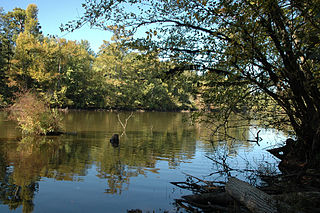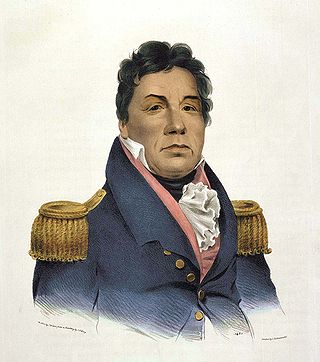Related Research Articles

Pushmataha County is a county in the southeastern part of the U.S. state of Oklahoma. As of the 2020 census, the population was 10,812. Its county seat is Antlers.

Atoka County is a county located in the U.S. state of Oklahoma. As of the 2020 census, the population was 14,143. Its county seat is Atoka. The county was formed before statehood from Choctaw Lands, and its name honors a Choctaw Chief named Atoka. The county is part of Choctaw Nation reservation lands.

Atoka is a city in and the county seat of Atoka County, Oklahoma, United States. The population was 3,195 as of the 2020 Census, a 2.4% increase over the 3,107 reported at the 2010 census, which was itself an increase of 4.0 percent from the figure of 2,988 in 2000.
McGee Creek Reservoir is a reservoir in Atoka County, Oklahoma. It impounds the waters of McGee Creek and several smaller streams, including Potapo, Panther, Little Bugaboo, Bear, Blue, Mill, and Crooked creeks, all of which are tributaries of Muddy Boggy River. According to the Bureau of Reclamation (BuRec), the reservoir was designed to extend 14 miles (23 km) up McGee Creek and 9 miles (14 km) up Potapo Creek when the water is at "conservation level.
Lane is an unincorporated community and census-designated place in Atoka County, Oklahoma, United States.
Farris is an unincorporated community in Atoka County, Oklahoma, United States. It lies east of the county seat of Atoka on Highway 3 near the county border.
Boggy Depot is a ghost town and Oklahoma State Park that was formerly a significant city in the Indian Territory. It grew as a vibrant and thriving town in present-day Atoka County, Oklahoma, United States, and became a major trading center on the Texas Road and the Butterfield Overland Mail route between Missouri and San Francisco. After the Civil War, when the MKT Railroad came through the area, it bypassed Boggy Depot and the town began a steady decline. It was soon replaced by Atoka as the chief city in the area. By the early 20th century, all that remained of the community was a sort of ghost town.

Choctaw Country is the Oklahoma Department of Tourism and Recreation's official tourism designation for Southeast Oklahoma. The name was previously Kiamichi Country until changed in honor of the Choctaw Nation headquartered there. The current definition of Choctaw Country includes ten counties, being Coal, Atoka, Bryan, Choctaw, McCurtain, Pushmataha, Le Flore, Latimer, Haskell, and Pittsburg counties. The department created the term as one of six designated travel regions within the state. However, other definitions of Southeastern Oklahoma may include additional counties.
The Battle of Middle Boggy Depot, also known as the Battle of Middle Boggy River or simply Battle of Middle Boggy, took place on February 13, 1864 in Choctaw Indian Territory, 4 miles (6.4 km) south of what is now Allen in Pontotoc County, Oklahoma. Advancing down the Dragoon Trail toward Fort Washita, Union Colonel William A. Phillips sent out an advance of approximately 350 men from the 14th Kansas Cavalry and two howitzers to attack a Confederate outpost guarding the Trail's crossing of Middle Boggy River. The Confederate force was led by Captain Jonathan Nail and composed of one company of the First Choctaw and Chickasaw Cavalry, a detachment of the 20th Texas Cavalry and part of the Seminole Battalion of Mounted Rifles. The outpost was about 12 miles (19 km) from Muddy Boggy Depot, which was held by the Confederates. The Encyclopedia of Oklahoma History and Culture says that the battlefield was 15 miles northeast of the depot, whereas the battlefield marker says the distance was 12 miles. The Confederate force at the outpost, consisting of 90 poorly armed men, were caught off guard when Willetts attacked them. Outnumbered and outgunned, the Confederates held off the Union cavalry attack for approximately 30 minutes before retreating to the rest of Lt. Col. John Jumper's Seminole Battalion, who were not at the main skirmish. The Confederates retreated 45 miles (72 km) southwest down the Dragoon Trail. The Union advance continued south toward Ft. Washita the next day, but when the expected reinforcements did not arrive Philips' Expedition into Indian Territory stalled on February 15, near old Stonewall.

The Little River is a tributary of the Red River, with a total length of 217 miles (349 km), 130 miles (210 km) within the Choctaw Indian Reservation in southeastern Oklahoma and 87 miles (140 km) in southwestern Arkansas in the United States. Via the Red, it is part of the watershed of the Mississippi River. Six large reservoirs impound the Little River and its tributaries. The drainage basin of the river totals 4,204 square miles (10,890 km2), 2,204 square miles (5,710 km2) in Oklahoma and 2,036 square miles (5,270 km2) in Arkansas. The Little River and its upper tributaries are popular for recreational canoeing and kayaking.
Muddy Boggy Creek, also known as the Muddy Boggy River, is a 175-mile-long (282 km) river in south central Oklahoma. The stream headwaters arise just east of Ada in Pontotoc County. It is a major tributary of the Red River in south central Oklahoma. Clear Boggy Creek is a major tributary which enters the Muddy Boggy at a location known as River Mile 24 in Choctaw County. The river is inhabited by over one hundred species of fish.
Clear Boggy Creek, also known as the Clear Boggy River, is a 132-mile-long (212 km) creek in southeastern Oklahoma that is a tributary of Muddy Boggy Creek.
Jumbo is an unincorporated community in western Pushmataha County, Oklahoma, United States, 10 miles north of Miller.
Jack's Fork County, also known as Jack Fork County, was a political subdivision of the Choctaw Nation of Indian Territory. The county formed part of the nation's Pushmataha District, or Third District, one of three administrative super-regions.
Johns Valley is a geographic feature and place name located in the Kiamichi Mountains in northwestern Pushmataha County, Oklahoma. The valley is formally classified by geologists as a "basin" due to its complete encirclement by mountains.

Pushmataha District was one of three provinces, or districts, comprising the former Choctaw Nation in the Indian Territory. Also called the Third District, it encompassed the southwestern one-third of the nation.

Pushmataha County was a proposed political subdivision created by the Sequoyah Constitutional Convention. The convention, meeting in Muskogee, Indian Territory in 1905, established the political and administrative layout of a prospective U.S. state it called the State of Sequoyah.

The Black Kettle National Grassland, in Roger Mills County, Oklahoma, and Hemphill County, Texas, contains 31,286 acres (12,661 ha) of which 30,710 acres (12,430 ha) are in Oklahoma.

Atoka County was a political subdivision of the Choctaw Nation of Indian Territory, prior to Oklahoma being admitted as a state. The county formed part of the Nation's Pushmataha District, or Third District, one of three administrative and judicial provinces called districts.
References
- ↑ "McGee Creek". Geographic Names Information System . United States Geological Survey, United States Department of the Interior . Retrieved January 26, 2025.
- ↑ Per correspondence from the Oklahoma Water Resources Board dated April 6, 2023, the agency has no specific information regarding McGee Creek.
- ↑ “McGee Creek WMA.” Oklahoma Department of Wildlife Conservation. https://www.wildlifedepartment.com/hunting/wma/southeast/mcgee-creek-wma. Accessed on April 11, 2023. "McGee Creek Project, Oklahoma." Bureau of Reclamation. Undated; circa 1981. A physical copy is on file in the Antlers Public Library in Antlers, Oklahoma.
- ↑ "McGee Creek [Lake]". Oklahoma Department of Wildlife Conservation. https://www.wildlifedepartment.com/fishing/wheretofish/southeast/mcgee-creek. Accessed on April 11, 2023. "McGee Creek Project". U.S. Bureau of Reclamation. https://www.usbr.gov/projects/index.php?id=351. Accessed on April 11, 2023. "McGee Creek Project, Oklahoma." Bureau of Reclamation. Undated; circa 1981. A physical copy is on file in the Antlers Public Library in Antlers, Oklahoma.
- ↑ Wright, Muriel H. "Some Geographic Names of French Origin in Oklahoma." Chronicles of Oklahoma. Volume 7, Number 2, pp. 188-193.
- ↑ Interview with Louis Pierce, who lived on Boggy Bend in Atoka County, in 1937. Pierce mentions McGee Creek specifically. Other interviewees, including Aaron McFarland and W.H. Mangers, mention the Muddy Boggy region generally. Indian-Pioneer Papers, Western History Collections of the University of Oklahoma Libraries.
- ↑ “Map of Choctaw Nation, Indian Territory: Compiled from Official Records of the United States Geological Survey,” dated 1900, published by the U.S. Department of the Interior. It is not known whether the French named McGee Creek as well, or considered it a branch of the Vazzures.
- ↑ Interview with Wilburn Thompson, Indian-Pioneer Papers, Western History Collections of the University of Oklahoma Libraries. Thompson was a Choctaw Indian who lived at Bruno, southwest of McGee Creek. He was interviewed in 1937 regarding life during territorial times. No information is available regarding Charles McGee. He does not appear on the Final Roll of the Five Civilized Tribes, nor does he appear in federal census records taken after statehood.